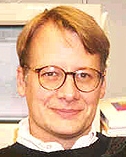explore and connect
InterViews:
» By Last Name
» By Subject
» About the Series
InterViews
 Lyman Page
Lyman Page
astronomy
(recorded in 2007)
Listen or download interview (mp3, 26 minutes, 26MB)
 Subscribe directly through iTunes
Subscribe directly through iTunes
Although Lyman Page once spent a year in Antarctica and two years sailing the Atlantic, his greatest adventure is no less than mapping the universe. As a key member of the WMAP (Wilkinson Microwave Anisotropy Probe) mission, Page helped measure the cosmic microwave background, a backdrop of cosmic static visible everywhere in the sky and thought by physicists to be the afterglow of the Big Bang.
The data he and his team gathered with WMAP shed new light on the shape, composition, evolution and age of the universe a feat that led Science magazine to label the mission the 2003 “Breakthrough of the Year.”
For his achievements in cosmology, the study of the universe’s structure and evolution, Page was elected to the National Academy of Sciences in 2006. He serves as the Henry DeWolf Smyth Professor of Physics at Princeton University.
Interview Highlights
After stints in California, Virginia, and New Hampshire, Page’s pediatrician father and artist mother settle in Maine, where he spends much of his childhood and high school years. Page enters Maine’s Bowdoin College planning to major in philosophy or English, but a first-semester physics class captivates him and sends him to the college library in search of books about the field. He discovers astrophysics and cosmology through a chance encounter with Gravitation, a 1973 textbook on Albert Einstein’s theory of general relativity, and decides that’s the kind of physics he’d like to do. But he doesn’t feel “mentally prepared” for physics graduate school when graduation rolls around. He instead sets out for a cosmic ray station on McMurdo Sound, about 700 miles from the South Pole.
updated 7-29-09
Visit the NAS member directory for current information on Lyman Page.
The audio files linked above are part of the National Academy of Sciences InterViews series. Opinions and statements included in these audio files are those of the interviewee and do not necessarily reflect the views of the National Academy of Sciences.

